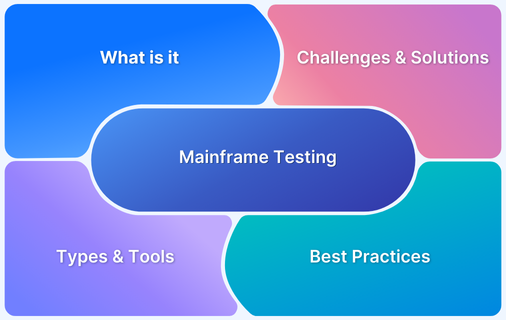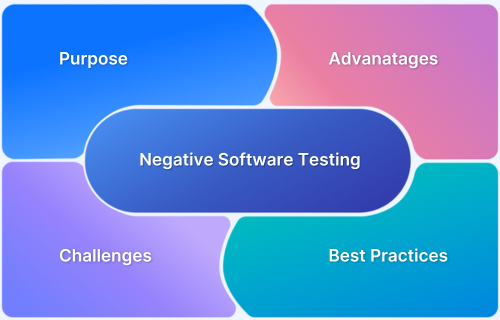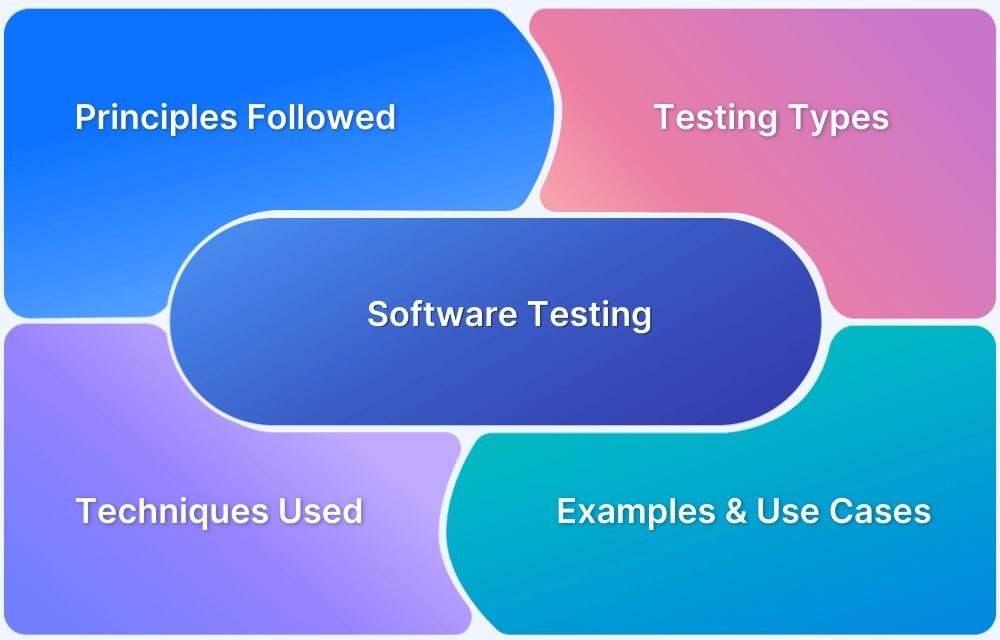If the database grows to millions of records, a software app might have delayed responses, slow processing, and crashes. Volume testing minimizes the chances of this scenario.
Overview
What is Volume Testing
Volume testing is a type of performance testing that checks how your system performs when there is a large volume of data to handle.
Key Aspects of Volume Testing
- System response duration
- Managing high transaction loads
- Data storage
- Data overwriting
- Management of high transaction loads
- Handling large amount of data
In this article, learn what volume testing is, how to conduct volume testing, challenges and benefits, types, key aspects, and more.
What is Volume Testing in Software Testing
Volume testing is a type of performance testing that checks how your system performs when there is a large volume of data to handle.
The goal is to see if the app can handle expected high loads. This helps avoid slowdowns or crashes. It also shows how response time and system behavior change when the data increases.
Take an example. A CRM tool works fine with 10,000 records. But with 10 million, problems may show up. You might see slow responses or memory leaks. Volume testing helps catch these early. This gives teams time to fix and tune the system.
Read More: Top 20 Performance Testing Tools
Objectives of Volume Testing
The main goal is to see how your software handles large amounts of data.
Here is what it checks:
Volume Testing Goals:
- How the app performs when there is a lot of data
- If there is data loss or delays
- How well the system grows as data grows
- Use of memory, CPU, and other resources
- If the app stays stable and reliable as data increases
Volume Testing Importance
Volume testing helps you see how your software handles a lot of data. It makes sure things stay stable and accurate, even as your data grows.
- Detect performance issues: Helps uncover performance problems that show up only when the system deals with a large amount of data.
- Minimizes system crashes: Reduces the risk of system crashes by identifying how much data the application can safely handle.
- Maintains accuracy: Keeps your system steady and responsive and confirms that data stays accurate and intact, even as its volume grows.
- Finds pressure points: Pinpoints pressure points like slow databases or hardware limitations.
- Improves response times: Helps increase response times by detecting and resolving issues associated with large data volumes.
- Improve system durability: Flags weak areas that could lead to data loss, helping teams improve system durability.
- Guides Scalability plans: Guides your scalability plans, whether you are expanding vertically or horizontally.
- Rich Insights: Offers valuable input for planning capacity and estimating how much load your system can take.
When to Perform Volume Testing
Volume testing is a very important step to see how your software application handles large amounts of data. It helps you understand how things work under real-world conditions. Here are the situations where you should consider performing volume testing:
- After functional testing: Once you verify that your system’s features are working, test if they still function well when handling large amounts of data. This ensures that performance holds up when data increases.
- Before going live: Test your application before it is launched. This allows to ensure that it can handle actual user activity and data influx. It’s important to confirm that everything works smoothly.
- During major updates or migrations: If you’re changing your database or adding new features, volume testing checks if these changes affect performance when the data grows.
- When scaling the application: If you’re adding more products to your platform or more content or the likes to support new users and market, then conducting a volume test helps ensure that your system handle the extra load without slowing down.
Key Aspects of Volume Testing
If you want your system to handle large amounts of data smoothly, it helps to know what volume testing looks for. Here are the main areas to focus on:
- System response duration: Checks how fast the system reacts during high demand. It’s essential to provide a quick, good experience for users.
- Data loss prevention: Ensures that no data is lost during high load. It helps keep the data intact and prevents issues for users.
- Data storage: Ensures data is stored correctly even with a heavy load, preventing corruption and ensuring easy access.
- Data overwriting: Makes sure data isn’t overwritten without permission, protecting data integrity.
- Handling large data volumes: Tests if the system can manage huge amounts of data without slowing down.
- Managing high transaction loads: This shows how the system performs when many actions happen at once and how well it can keep up when activity increases.
Types of Volume Testing
When running volume testing, you are not just checking one thing. There are different types, and each one looks at how your system handles a heavy data load in its way. Here are the different types of volume testing:
- Distributed system volume testing: Tests how a distributed system that comprises multiple servers, databases, or services manages a large volume of data. This is to ensure its stability, consistency, and performance under heavy data load.
- Data transfer volume testing: It focuses on large uploads, downloads, or migrations. It tests how your system performs when there is a big data shift.
- Network volume testing: It checks how your system handles high network use, including delays or any data that gets lost.
- Batch processing volume testing: Checks how well the system runs big tasks in one go, like backups or processing large sets of records.
- Data storage volume testing: Tests if the system can store and pull up growing data without slowing down.
- Transaction volume testing: Focuses on how the system handles lots of transactions happening at once. It shows if everything still runs smoothly when activity is high.
Volume Testing Examples in Real Life
Volume testing shows up in everyday tech, even if you do not always notice it. It helps teams make sure systems still run smoothly when the data gets heavy. Here are a few real-life examples:
- E-commerce platforms: These platforms often add thousands of products at once. Volume testing makes sure the search, filters, and checkout still work fast, even when the product list keeps growing.
- Banking apps: Such apps process millions of transactions every day. This testing helps ensure that everything goes through on time, without glitches or delays.
- Streaming services: Streaming services employ volume testing, too. It helps them manage huge video libraries and lots of users watching at the same time, all without buffering or crashes.
Volume Testing Working
Volume testing simulates heavy data loads to see how the system performs under pressure. It checks if the system can process, store, and retrieve large amounts of data. The testing is done in a controlled setting to make sure the system can handle real-world data growth without crashing.
For instance, if you are testing a banking app, you might load it with a large amount of customer transactions (maybe in millions) to verify if it still processes payments instantly and accurately.
How to Perform Volume Testing
To conduct volume testing, you replicate extensive data loads on your system. This allows you to verify if it can manage substantial data loads without experiencing slowdowns or failures. Initially, set up your environment, and afterward, create extensive datasets. Then, watch how the software handles and retains data during peak demands. Here is an easy guide to assist you:
Prerequisites to Testing Volume
- Make sure the system is reliable and operating correctly.
- Establish a testing environment that mimics a large data volume.
- Develop a test plan that details the conditions for testing.
- Understand the type of database you are using.
- Ensure you have the required resources, like a load testing tool or volume testing software.
Process
Here is the step-by-step process to conduct volume testing:
Step 1: Define Objectives
Before you begin, consider what you aim to test. Are you measuring response time or data transfer speed? Establish specific objectives so you understand what to evaluate during the test.
Step 2: Prepare the Test Environment
Your test environment should match the live setup. Use the same hardware, software, and network configurations to make sure the test results are realistic.
Step 3: Test Data
Create large datasets for the test. Using real or synthetic data, make sure it reflects what the system will handle in production.
Step 4: Apply Data Loads
Gradually introduce large data volumes to the system. Simulate real-world usage to observe how the system behaves under pressure.
Step 5: Execute Tests
Run the tests and keep an eye on system behavior. Track response times, resource usage, and any errors that pop up during the test.
Step 6: Analyze Results
After the test, analyze the results. Look for issues like slow processing or crashes that might indicate system limitations.
Step 7: Optimize and Re-Test
If issues arise, optimize the system. This could involve improving database queries, adding better caching, or upgrading hardware. After making improvements, run the tests again to check if performance has improved.
Read More: Response Time Testing in Software Testing
Volume Testing vs. Load Testing vs. Stress Testing
Volume testing, Load testing, and Stress Testing all evaluate performance but in different ways. Volume Testing checks data handling, load testing simulates expected user traffic, and stress testing pushes the system to its limits to test recovery.
| Aspect | Volume Testing | Load Testing | Stress Testing |
|---|---|---|---|
| Objective | Evaluate system performance under heavy data volume | Simulate real-world load and ensure system performance | Test system limits under extreme conditions |
| Focus | Data handling and storage | System’s behavior with expected user load | System stability and recovery under overload |
| Test Conditions | Large volumes of data | Normal to peak expected load | Beyond normal capacity or peak load |
| Primary Goal | Ensure scalability and data management | Validate system’s response time, throughput, and stability | Identify the system’s breaking point |
Best Volume Testing Software
Here are few tools that will help you run volume tests:
- Gatling: Gatling is an open-source tool that is great at handling heavy data loads. It is also developer-friendly and fits well into CI/CD pipelines. So, if you want to automate your performance testing, Gatling is a strong pick.
- BlazeMeter: Blazemeter is built based on JMeter and runs in the cloud. You can run large-scale tests, analyze app performance metrics in real-time, and even collaborate with your team easily.
- Apache JMeter: JMeter is another open-source option. It is widely used for both volume and load testing. If you need something flexible and free, this tool is worth trying.
- NeoLoad: This tool helps you simulate a lot of users at once. It is useful when you want to see how your system reacts under high traffic and pressure.
- BrowserStack: BrowserStack Load Testing is a cloud-based platform designed to simulate large-scale, real-world traffic and perform volume testing. It allows teams to test how their application handles high user volumes, ensuring performance remains stable under stress.
Benefits of Volume Testing
Following are the benefits of volume testing:
- Identify roadblocks: Identify areas where the app slows down because of large volumes of data and optimize it.
- Improve performance: Ensures the system handles large volumes of data without performance deterioration.
- Improve scalability: Verifies if the app can handle larger volumes of data and scale smoothly.
- Ensure data integrity: Helps maintain data accuracy under load.
- Enhanced user experience: By preventing slowdowns and crashes and ensuring optimized performance, volume testing helps facilitate a smooth user experience.
Volume Testing Checklist
To make sure your system handles large data volumes, use this checklist:
- Check that your test environment has enough storage, memory, and processing power.
- Gather or create realistic test data that matches real-world situations.
- Inject the data into the system using scripts or tools, making sure all cases are covered.
- Define different test scenarios with varying data amounts, including extreme cases.
- Monitor the system’s performance using tools to track things like response time, CPU, memory, and database health.
- Check that the data stays accurate, consistent, and intact during the test.
- Test how the system scales as data increases and handles sudden spikes.
Best Practices in Volume Testing
For effective volume testing and reliable results, follow these best practices:
- Define clear objectives: Make sure that you set defined goals; for instance, manage 1 million records in 5 seconds.
- Realistic data: Simulate data that aligns with real-world conditions, for instance, real user transactions for a banking app.
- Test all components: Make sure you test all components, including database, API, and front-end.
- Increase load gradually: Make sure you increase load slowly i.e you can start with small loads and scale up to detect issues.
Challenges of Volume Testing and Solutions
From setting up the environment to generating data, volume testing can bring a few challenges. But each one has a simple way out.
1. Difficulty in creating realistic large datasets
Solution: Use data generation tools or anonymized production data.
2. Limited resources in the test environment
Solution: Scale infrastructure using cloud services or virtual machines.
3. Tests take too long to complete
Solution: Run tests during off-peak hours or execute them in parallel.
4. Storage limitations
Solution: Use temporary high-capacity storage and clean up unnecessary test data.
5. Monitoring performance is tough
Solution: Use tools like Grafana, JMeter, or New Relic for real-time tracking and alerts.
AI Trends in Volume Testing
AI is changing volume testing by making it more efficient and accurate.
- Predictive Analytics: AI can predict system behavior under load based on past history to identify issues early.
NLP for test results: Natural language processing (NLP) can be used to summarize test results. - Intelligent Resource Allocation: AI helps optimize resource consumption udring volume testing.
- Dynamic load adjustment: Based on system performance, AI can adjust test load in real-time.
Why choose BrowserStack?
BrowserStack Load Testing is a powerful cloud-based solution that helps teams assess their application’s ability to handle high traffic volumes. By simulating large-scale, real-world user traffic, it ensures that your app remains stable and responsive under heavy data loads. Key features include:
- Simulate thousands of virtual users from multiple geographies
- Comprehensive insights for both frontend and backend performance
- Seamless CI/CD pipeline integration for automated volume testing
- Real-time monitoring to identify and resolve performance issues under stress
Conclusion
Volume testing ensures that software can manage substantial data loads without any problems. It aids in recognizing bottlenecks and vulnerabilities in the system promptly. With AI, testing accelerates and improves, providing automation. Volume testing enhances user satisfaction and facilitates long-term scalability.
To further enhance testing, you can integrate your volume testing tool with real-device clouds like BrowserStack to combine volume test scripts with visual/device validation. You can access 3500+ real-device, browser and OS combinations for facilitating a complete performance validation under increased data volume and deliver a seamless user experience across diverse environments.
Frequently Asked Questions
1. Is volume testing the same as performance testing?
No, they’re different. Volume testing is a type of performance testing that checks how well a system handles large amounts of data. Performance testing looks at how the system responds and if it is stable under different conditions.
2. Can volume testing be automated?
Yes, it can. Tools like Apache JMeter, Blazemeter, Gatling etc. can automate volume testing by generating large datasets, monitoring system performance, and analyzing results.







